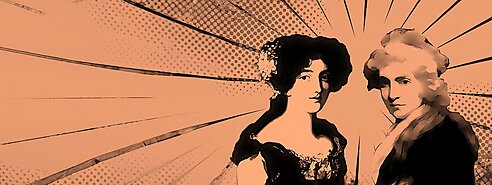In this lesson, students will learn about the lives and legacies of Mary Astell and Mary Wollstonecraft, two feminist authors whose philosophical ideas helped form the basis for later movements for gender equality and female empowerment.


What do you know about Mary Astell and Mary Wollstonecraft?
Before reading, watch this overview of Mary Astell’s life until 5:23 in the video.
Then watch this three minute video about Mary Wollstonecraft.
In partners, small groups, or as a whole class, have students answer these questions:
- What are three interesting facts you learned about Mary Astell and Mary Wollstonecraft?
- What is one question you have about each woman?
Questions for Reading, Writing, and Discussion
Read the article, then answer the following questions:
- Alexander C.R. Hammond writes that, “In the 17th and 18th centuries, Western European women were often poorly educated and had very little protection under the law.” What were some of the ways that Astell and Wollstonecraft suffered under this system? Cite at least two specific examples of the hardships these women faced, one for Astell and one for Wollstonecraft.
- In the 1600s, women were not treated as equal partners in marriage. In her book Some Reflections upon Marriage, which two specific reforms did Astell propose to the institution of marriage?
- Both Astell and Wollstonecraft advocated for better education for women. What were their proposals? What were the philosophical reasons for their positions?
| Which education reforms did they seek? | What philosophical arguments did they use to support their positions? | |
|---|---|---|
| Astell | ||
| Wollstonecraft |
- What was a key difference between Astell and Wollstonecraft concerning political reform?
- Perform a thought experiment. Imagine that Astell and Wollstonecraft were born in the year 2000. Many of the reforms Astell and Wollstonecraft worked. Such changes to education, marriage, and voting laws had been achieved by then. If they were alive today, what further changes to women’s lives do you think they would work for?
For each category below, write at least one reform that you think Astell and Wollstonecraft would seek to change in the 21st century.
| Current Issue | What reforms do you think Astell and Wollstonecraft would propose to improve women’s lives today? |
|---|---|
| Gender pay gap | |
| Lack of workplace accommodations for childbearing and childcare | |
| Sexual harassment at school and work | |
| Domestic violence |
Extension Activity/Homework
- Be a Contrarian.
Most people in the United States today see nothing radical about the proposals Astell and Wollstonecraft made during the 17th and 18th centuries. These two writers sought equal rights and opportunities for women in education, marriage, and political representation.
Imagine that you are a contemporary of Wollstonecraft living around the time of the French Revolution. You do not support her positions. Think critically and argue against her ideas. What philosophical, historical, biological, and/or religious reasons would you use to refute her calls for equality?
- Write a Eulogy for Mary Astell or Mary Wollstonecraft
In addition to being first‐rate intellectuals and writers, Astell and Wollstonecraft were both strong, independent women who persevered despite discrimination and personal setbacks.
After reading the article, write a eulogy, a short piece normally read at a memorial service or funeral, for either Mary Astell or Mary Wollstonecraft. Choose the person whose life resonates most with you. Your eulogy should honor and remember her life and accomplishments. - What were the challenges she faced and how did she meet them?
- What did she achieve, both personally and professionally?
- How does she inspire you to reach your goals?
- What is her legacy?